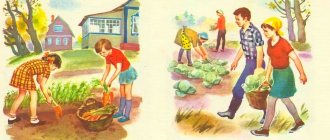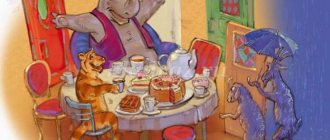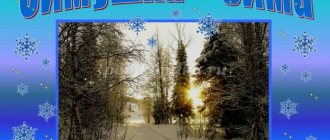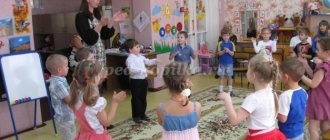Integrated and comprehensive classes
Integrated learning allows you to see and understand any phenomenon holistically; in kindergarten there is a subject-based learning system and it often turns out that knowledge remains scattered, artificially divided according to the subject principle, and as a result, children do not always holistically perceive the whole picture of the world around them.
Integrated classes are a combination of several types of activities. Complex classes within the framework of one topic solve different problems of children's development and are based on different types of activities. These classes can be carried out in all age groups, but they are especially useful with older preschoolers.
The section of the site, integrated and comprehensive classes in kindergarten for different groups, contains many interesting publications for educators on teaching children on various topics:
- Scenario for an integrated lesson in kindergarten
- Integrated lesson on application and ecology in kindergarten
- Summary of an integrated educational activity in kindergarten with children 3-4 years old
- Summary of an integrated educational activity with children 2–3 years old in kindergarten
- Lesson summary for younger children integrated lesson in junior group 2
- Synopsis of the integrated GCD preparatory group of kindergarten
- Summary of GCD in kindergarten
- Summary of an integrated lesson in the middle group of kindergarten
- Summary of an integrated lesson for Victory Day in kindergarten
- Summary of an integrated lesson in kindergarten with children of senior preschool age
- Summary of integrated organized educational activities
- Summary of an integrated lesson on cognitive-speech and artistic-aesthetic development of children in the second junior
- Integrated lesson in the preparatory group
- Summary of an integrated lesson on the Russian language and the surrounding world for a preparatory school group
- Integrated open lesson with children of the preparatory group
- Summary of an integrated lesson for the middle group of kindergarten
- Integrated open lesson
- Integrated lesson for the middle group
- Open integrated lesson on speech development, the environment and mathematics in the preparatory group of kindergarten
- Summary of an integrated lesson on ecology and speech development, senior mixed-age group
- Summary of integrated OOD in the senior group
- Summary of integrated OOD in the preparatory group
- Summary of an integrated lesson in kindergarten
- Summary of the final integrated lesson in the first junior group
The most important thing in integrated classes in a preschool educational institution is the unity of goals, understanding of the techniques, methods, tasks that determine the harmonious development of the child’s personality, in other words, the ability to “crawl”, “enter” the pedagogical process, without creating stress for children, literally physically reducing to level of their eyes and focusing, in organizing their work, on their right-hemisphere characteristics. A fundamentally important point in organizing integrated classes in preschool educational institutions will be the activation of all mental processes that ensure successful learning.
The modern direction of development of the educational system has affected all kindergartens in the country without exception. Now integrated classes in preschool educational institutions are considered popular and most effective. The Ministry of Education approves and encourages the comprehensive development of students, as evidenced by a number of recommendations from the Federal State Educational Standard. What are integrated classes? In general, training according to a similar principle involves the simultaneous development of the child.
Integrated lesson in kindergarten - combines knowledge from various educational fields, on an equal basis, complementing each other (for example: the concept of “autumn” is considered through the means of music, art, painting, ecology). At the same time, in such a lesson, the teacher solves several development problems.
An integrated lesson is an activity that is aimed at revealing the holistic essence of a certain topic through different types of activities, which are combined in the broad information field of the lesson through mutual penetration and enrichment.
Summary of an integrated lesson with children of the senior group
Summary of the integrated lesson. Topic: Family is the pillar of happiness (older age)
Author: Kulinko Svetlana Yuryevna
Goal: fostering love and respect for family and friends, knowledge of one’s last name, first name and patronymic of parents, family tree and pedigree. Objectives: 1.Give initial information about the family, family relationships, form an idea of the family as people who live together (“Cognition”) 2.Clarify the most significant information about the child’s relatives, cultivate a sense of respect for older family members, desire for them help (“Socialization”) 3. Activate the names of relatives, first names and patronymics of parents in children’s speech, teach them to form nouns with diminutive suffixes, improve dialogic and monologue speech (“Communication”) 4. Strengthen the ability to draw a person’s face (eyes, nose , mouth) with felt-tip pens, develop emotional responsiveness, creative independence, aesthetic taste (“Artistic Creativity”) 5. Develop motor activity (physical minute “Children Help Parents”) (“Physical Education”) Preliminary work: *reading stories - L. Kvitko “Grandma’s Hands”, A. Yakovlev “Mother”; *children’s drawings on the theme “My Family”; * joint drawings with parents “My Joy”; *joint discussion of the meaning of proverbs about mother and family; *photo exhibition “I am with my grandmother”; *conversation with children about family members and family relationships; learning poetry; selection of photographs for the album “My Family”; *printed board games. Material: Demonstration material: house layout, pictures on the topic “Family”; Handouts: colored cardboard, strips of colored paper, glue, glue brush, scissors, napkin, cloud and sun (according to the number of children), circles of different sizes for each child. Musical accompaniment: song “My Family” lyrics. and music A. Ermolov, performed by L. Grigorieva. Progress of the lesson: Organizational moment: Educator: A sparrow walked along the roof, gathering his friends. There are many, many, many of us. The girls will come out now. The teacher, together with the girls, calls the boys. 1 part. Educator: - Hello, children, you are the most beautiful in the world. Are you in a good mood? Children: - Yes! Educator: - With such a wonderful mood, I invite you to visit the girl Masha. Children sit on chairs. Educator: - Masha lives in this beautiful house (I draw the children’s attention to the model of the house). But Masha does not live alone. To find out who Masha lives with, we need to solve riddles. (If the answers are correct, I place circles in the windows of the house to represent family members). Listen carefully. 1.Who washes, cooks, sews, gets tired at work, wakes up so early? - Only caring... (mother) 2. Who will teach you how to hammer a nail, Let you steer the car, And tell you how to be brave, Strong, dexterous and skillful? You all know, guys, - This is our favorite... (dad) 3. Who will knit socks for the grandchildren, tell an old fairy tale, give pancakes with honey? - This is ours... (grandmother) 4. He did not work out of boredom, His hands are calloused, And now he is old and gray - My dear, beloved... (grandfather) 5. Who is the cheerful little one - Crawling quickly on his belly?
Amazing boy - This is my youngest.. (brother) 6. Who loves both me and his brother, But loves to dress up more? Very fashionable girl My youngest... (sister) Educator: -Now look what we got. And we got a diagram - mom, dad, grandma, grandpa, brother, sister.
How can you call this in one word? Children: - Family. Educator: - Let's think about it. The family consists of relatives of different ages. The oldest in the family are (grandparents). Younger than grandparents are... - Mom and Dad. - The youngest in the family are... - These are children. — Masha and I drew up a diagram of her family. - And now each of you will draw up a diagram of your family. Remember that the small circles are children, the larger ones are mom and dad, and the largest ones are grandparents. (Children lay out diagrams on the tables.) Educator: - Okay, everyone did it. Part 2. Educator: - Masha really wanted to know about your families, tell us about your family. Educator: - Shall we tell the girl Masha about our families? (questions for children) Educator: - Sasha, name the members of your family. Who are you in the family? - For a mother, a son, for a grandmother, a grandson, for a sister, a brother. Educator: - Who is your mother’s mother for you? What about you for her? Educator: - Who is the eldest in your family? Educator: - Who is the youngest? Educator: - How do you take care of your family members? Educator: - Do you love your loved ones? Why? Stories from 3-4 children. Educator: - Well done! It’s good that there is a family where they love each other, help and take care of each other. Educator: - Do you like to help your loved ones? Children: - Yes! Educator: - Now we’ll check. 1.D/i “Little Helpers”. Educator: - The car’s relatives need help. I have pictures on the board, name them. (Mop, rag, dustpan, broom, scarf, hat, jacket, boots, hammer, nails, pliers, screwdriver). Educator: - Mom decided to clean the apartment. What does she need? (helpers should bring her a bucket, rag, mop, dustpan, broom). Educator: - Dad decided to fix the chair. What does he need? (assistants should bring the following tools - hammer, nails, pliers, screwdriver). Educator: - Little brother is going for a walk. What does he need? (helpers carry: scarf, hat, boots, jacket). Educator: - Grandma is knitting a sweater (helpers carry a ball and knitting needles). Educator: - Well done, guys, you are real helpers to your parents. Now we know that each family member has his own household responsibilities. Educator: - What household responsibilities do you have? Children: - Wipe the dust, water the flowers, sweep the floor. Educator: - Are you probably tired? Let `s have some rest. 2. Physical exercise “Children help parents.” Children perform movements corresponding to the text. I love my mother and I will always help her: I wash, rinse, I shake off the water from my hands, I sweep the floor clean and pat the carpet. Mom needs to rest, Mom wants to sleep. I walk on tiptoe and I never say a single word, shh... 3.D/i “Joy and Sadness” Educator: - Guys, how do we express love for our loved ones? Children: - We help, we obey. Educator: - That's right! We also do good deeds and never do bad ones, so as not to upset our parents. What do you think joy (sadness) looks like like the sun or like a cloud? Children: - Joy is like the sun, and sadness is like a cloud. Educator: - I will name actions. If you think that this act will upset your mother, raise a cloud; if it pleases, raise the sun. Educator: - They painted a beautiful picture; — Got into a fight with a friend; — We ate semolina porridge; — Put the toys back in place; - They tore the book; — My jacket got dirty while out for a walk. (children hold up the corresponding pictures) Educator: - Well done, children! Do only good deeds and the sun will always shine on you. Educator: - Guys, I see that you all love your family very much and Masha also loves her family very much. It’s so good when a person has a friendly family. In the family, everyone calls each other affectionately, tenderly, because they love each other. How can you affectionately call your daughter? 4. Game “Say kindly” Children: daughter, daughter Son - son, son Dad - daddy, daddy Grandfather - grandfather, grandpa Grandmother - grandma Sister - little sister Grandson - granddaughter Granddaughter - granddaughter Brother - little brother Educator: - It’s wonderful how much you you know kind words. You made me happy. It turns out that you are very affectionate and kind towards your family. Part 3. Educator: - In order to capture your happy families not only in your stories, but also on paper, today we will learn how to make a bookmark “My family is a cheerful palm.” And you can give it to your family. Educator: -Only in order for us to succeed in our work, we need to stretch our fingers. Finger game "Family". One two three four!
Claps for the count. Who lives in my apartment? One, two, three, four, five Claps for a count. I can count them all! Mom, dad, brother, sister Alternately stroking fingers. Murka the cat, two kittens, My goldfinch, the cricket and me, That’s my whole family! Showing fists (Children go to the tables).
Algorithm for making a bookmark: Educator: - Now, every finger on your piece of paper will turn into mom and dad, grandparents. Let's take a felt-tip pen and draw: eyes, nose, mouth, ears, hair. (Display on the board) The song “My Family” plays. and music A. Ermolov, performed by L. Grigorieva. Educator: 1. On a clean white sheet of thick paper, trace your right or left hand. 2. On each finger we create (with felt-tip pens) an image of our family members. 3. Cut along the contour. 4. Glue it onto a strip of thick paper. Individual approach during work. Upon completion of the productive activity, each bookmark is presented with a comment from the child (which family member is drawn on it). Educator: - Guys, you are all so great! What beautiful bookmarks you made. Your parents will be very happy with such a gift. Bottom line. Educator: - Who did we visit today? - Why does a person need a family? Let's say thank you to Masha for your hospitality.
We recommend watching:
Summary of GCD for introducing older preschoolers to the work of the poet Fet Summary of plot-based GCD in physical education for children of the senior group Summary of GCD in the senior group of compensatory orientation GCD in kindergarten for older preschoolers
Similar articles:
Summary of GCD in the senior group on the topic “Communication”
Summary of GCD in the senior group of kindergarten on the topic “Relaxation”
Summary of a lesson on cognition in the senior group on the topic “Dairy products”
Summary of a lesson on cognition in the senior group on the topic “Construction professions”
Abstract of educational activities for cognition in the senior group of kindergarten on the topic “Russian folk crafts”




